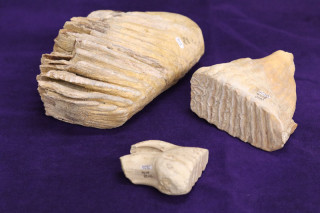Explorer Corps Marker: Summit County
Find the Marker
The Summit County marker is in the front lawn on the north side of the Kimball Junction Branch of the Summit County Library, at 1885 West Ute Blvd. The marker highlights the Ice Age fossils found at the former Silver Creek site nearby.
GPS 40°43’26.76”N 111°32’45.6”W
Dig Deeper
Imagine sabertoothed cats roaming the hills around Park City. That’s not the premise for a science fiction movie, but a real part of Utah’s prehistory. More than 12,000 years ago, during the last Ice Age, the mountains of Summit County were home to an entire menagerie of Ice Age animals whose remains were preserved in the vicinity of Silver Creek.
Ice Age finds have been made all over Utah, from a musk ox uncovered in the vicinity of Temple Square to a mammoth found in Bigwater near the Arizona border. Most of the time, however, these fossils come from single individuals that happened to be buried in just the right way at just the right time. The Silver Creek site is different. In this place, not far from Park City, an entire Ice Age community was preserved in one spot – a window into the not-so-distant past.

The Silver Creek fossil site was discovered in 1963. In that year, Allan J. Lewis was excavating a ditch to lower the water level on his property. In the process, he found a mammoth tooth. That was enough to gain the interest of James Madsen Jr., Utah’s first state paleontologist, and excavations at the site soon uncovered the fossils of 25 mammal species as well as amphibians, birds, and other small creatures.
Digging the fossils out was no simple task. The Ice Age layers that entombed the fossils were below the water table. Excavators had to constantly pump water out of the site to get to the fossils. But all the effort was worth it. The site offered a rare look at what Ice Age species were living at high altitudes, in the mountains, in Ice Age Utah and how this community differed from those found elsewhere.
Many of the fossils the crew found no longer live in Utah. The bones of Harlan’s ground sloth, dire wolves, mammoths, horses, camel, and saber-toothed cats were found at the site. But some of the fossils belonged to species that are still around today, including leopard frogs, mallards, sage grouse, white-tailed jackrabbit, and others. The collection is a reminder that many Ice Age species are still around and that we live very close in time to the days of the mammoths and sabercats.
So far as paleontologists and geologists have been able to discern, the fossils from the Silver Creek site represent animals that lived in the area between 100,000 and 40,000 years ago. Back then, the area was marshy and wet, bordered by a grassland where the mammoths and ground sloths roamed. The fact that this was a wet place, where sediment was being laid down in the marshes, helped to preserve the remains of the local fauna.
Exactly why many of the mammals found at Silver Creek disappeared is still debated by experts. Humans may have hunted some of the large species, like mammoths, while climate change was altering cold, dry habitats into warm, wet ones that favored different species. The answer might lie with a combination of both, vast ecological changes that paleontologists are still keying into. Perhaps some clues might be found in the Silver Creek collection, a remnant from a time when camels and giant sloths ambled along the slopes of the Wasatch Range.
Want to Go Farther?
Visit the Natural History Museum of Utah or the USU Eastern Prehistoric Museum in Price to learn more about Ice Age animals.